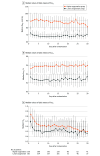Lower vs Higher Oxygenation Target and Days Alive Without Life Support in COVID-19: The HOT-COVID Randomized Clinical Trial
- PMID: 38501214
- PMCID: PMC10951852
- DOI: 10.1001/jama.2024.2934
Lower vs Higher Oxygenation Target and Days Alive Without Life Support in COVID-19: The HOT-COVID Randomized Clinical Trial
Erratum in
-
Table Data Errors.JAMA. 2024 May 28;331(20):1771. doi: 10.1001/jama.2024.7635. JAMA. 2024. PMID: 38691381 Free PMC article. No abstract available.
Abstract
Importance: Supplemental oxygen is ubiquitously used in patients with COVID-19 and severe hypoxemia, but a lower dose may be beneficial.
Objective: To assess the effects of targeting a Pao2 of 60 mm Hg vs 90 mm Hg in patients with COVID-19 and severe hypoxemia in the intensive care unit (ICU).
Design, setting, and participants: Multicenter randomized clinical trial including 726 adults with COVID-19 receiving at least 10 L/min of oxygen or mechanical ventilation in 11 ICUs in Europe from August 2020 to March 2023. The trial was prematurely stopped prior to outcome assessment due to slow enrollment. End of 90-day follow-up was June 1, 2023.
Interventions: Patients were randomized 1:1 to a Pao2 of 60 mm Hg (lower oxygenation group; n = 365) or 90 mm Hg (higher oxygenation group; n = 361) for up to 90 days in the ICU.
Main outcomes and measures: The primary outcome was the number of days alive without life support (mechanical ventilation, circulatory support, or kidney replacement therapy) at 90 days. Secondary outcomes included mortality, proportion of patients with serious adverse events, and number of days alive and out of hospital, all at 90 days.
Results: Of 726 randomized patients, primary outcome data were available for 697 (351 in the lower oxygenation group and 346 in the higher oxygenation group). Median age was 66 years, and 495 patients (68%) were male. At 90 days, the median number of days alive without life support was 80.0 days (IQR, 9.0-89.0 days) in the lower oxygenation group and 72.0 days (IQR, 2.0-88.0 days) in the higher oxygenation group (P = .009 by van Elteren test; supplemental bootstrapped adjusted mean difference, 5.8 days [95% CI, 0.2-11.5 days]; P = .04). Mortality at 90 days was 30.2% in the lower oxygenation group and 34.7% in the higher oxygenation group (risk ratio, 0.86 [98.6% CI, 0.66-1.13]; P = .18). There were no statistically significant differences in proportion of patients with serious adverse events or in number of days alive and out of hospital.
Conclusion and relevance: In adult ICU patients with COVID-19 and severe hypoxemia, targeting a Pao2 of 60 mm Hg resulted in more days alive without life support in 90 days than targeting a Pao2 of 90 mm Hg.
Trial registration: ClinicalTrials.gov Identifier: NCT04425031.
Conflict of interest statement
Figures



Comment in
-
Oxygen Supplementation in COVID-19-How Much Is Enough?JAMA. 2024 Apr 9;331(14):1177-1178. doi: 10.1001/jama.2024.2935. JAMA. 2024. PMID: 38501210 No abstract available.
-
In adults with COVID-19 and severe hypoxemia, lower vs. higher oxygenation targets increased days alive without life support.Ann Intern Med. 2024 Jul;177(7):JC77. doi: 10.7326/ANNALS-24-00558-JC. Epub 2024 Jul 2. Ann Intern Med. 2024. PMID: 38950395
References
Publication types
MeSH terms
Substances
Associated data
LinkOut - more resources
Full Text Sources
Medical

